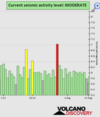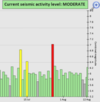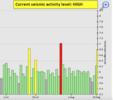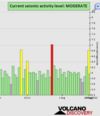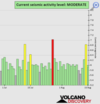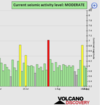EARTHQUAKE REPORT PAST 24HRS
Based on the averages of all earthquakes during the last 24 hours we had a moderate seismic activity. See Global seismic activity level chart
▪︎Strongest earthquake today M 5.4 - South Sandwich Islands region
2022-08-12 06:18:33 (UTC)
59.003°S 25.645°W. 40.9 km depth
USGS earthquake alert
▪︎M 5.2 - 11 km E of Zirándaro de los Chávez, Mexico. 2022-08-12 08:17:25 (UTC)
18.469°N 100.872°W. 64.0 km depth
USGS earthquake alert

 politica.expansion.mx
politica.expansion.mx
▪︎M 5.2 - 181 km NW of Tūkrah, Libya
2022-08-12 21:31:50 (UTC)
33.572°N 19.082°E. 14.8 km depth
USGS earthquake alert
Quakes in the past 24 hours:
~5 quakes above magnitude 5
~32 quakes between magnitude 4 and 5
~85 quakes between magnitude 3 and 4
~252 quakes between magnitude 2 and 3
~466 quakes below magnitude 2 that people normally don't feel.
~840 quakes past 24 h. (852 earthquakes in the 24 hours prior to this report) Estimated combined seismic energy released: 3.4 x 1013 joules (9.35 gigawatt hours, equivalent to 8047 tons of TNT or 0.5 atomic bombs!)
Volcanodiscovery earthquake report 24h
Based on the averages of all earthquakes during the last 24 hours we had a moderate seismic activity. See Global seismic activity level chart
▪︎Strongest earthquake today M 5.4 - South Sandwich Islands region
2022-08-12 06:18:33 (UTC)
59.003°S 25.645°W. 40.9 km depth
USGS earthquake alert
▪︎M 5.2 - 11 km E of Zirándaro de los Chávez, Mexico. 2022-08-12 08:17:25 (UTC)
18.469°N 100.872°W. 64.0 km depth
USGS earthquake alert
A 5.1 Richter magnitude earthquake was registered early this morning with an epicenter 34 kilometers from Ciudad Altamirano, Guerrero, which activated the alert protocols and systems, with no reports of any damage.
Laura Velázquez Alzúa, national coordinator of Civil Protection, detailed that the tremor was registered at 3:17 a.m. local time on Friday, August 12 and was felt with intensity in the coasts of Guerrero, being slightly felt in Michoacán and Mexico City.
The Center for Instrumentation and Seismic Registration reported that after the event, the seismic alert was activated in five cities: Acapulco and Chilpancingo in Guerrero; Morelia, Michoacán; Cuernavaca, Morelos and the country's capital.

Sin afectaciones, tras sismo de 5.1 grados con epicentro en Guerrero
Fue percibido también en Michoacán y en la Zona Metropolitana del Valle de México, donde en algunos puntos sonó la alerta sísmica.
▪︎M 5.2 - 181 km NW of Tūkrah, Libya
2022-08-12 21:31:50 (UTC)
33.572°N 19.082°E. 14.8 km depth
USGS earthquake alert
Quakes in the past 24 hours:
~5 quakes above magnitude 5
~32 quakes between magnitude 4 and 5
~85 quakes between magnitude 3 and 4
~252 quakes between magnitude 2 and 3
~466 quakes below magnitude 2 that people normally don't feel.
~840 quakes past 24 h. (852 earthquakes in the 24 hours prior to this report) Estimated combined seismic energy released: 3.4 x 1013 joules (9.35 gigawatt hours, equivalent to 8047 tons of TNT or 0.5 atomic bombs!)
Volcanodiscovery earthquake report 24h

